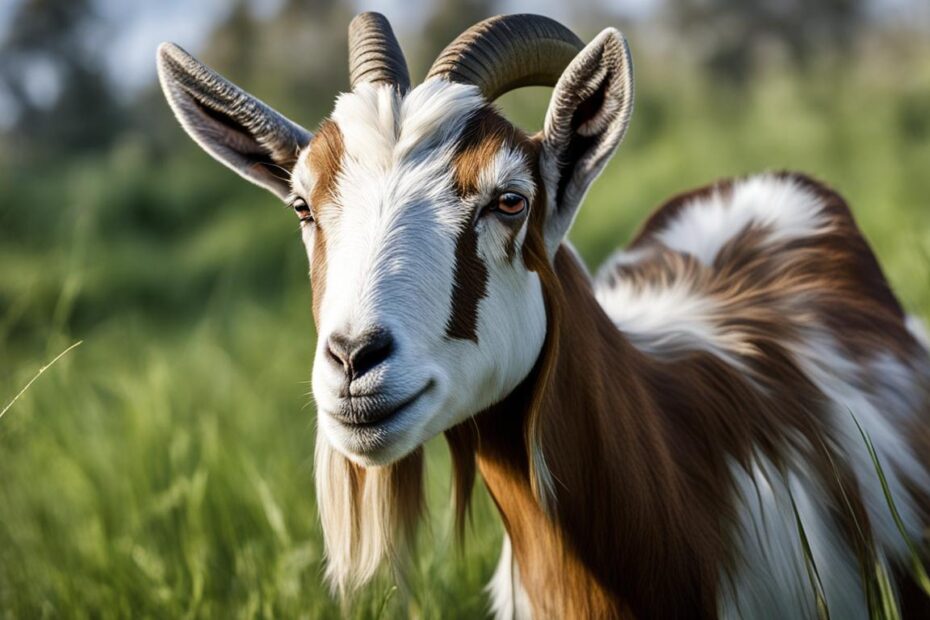Have you ever wondered why goats lift their upper lip? This fascinating behavior, known as the Flehmen response, is a unique aspect of goat behavior that provides valuable insights into their anatomy and communication. In this article, we will delve into the reasons behind this behavior, explore the intricacies of goat behavior, and gain a deeper understanding of these remarkable creatures.
Key Takeaways:
- Goats lift their upper lip in a behavior called the Flehmen response to investigate smells and gather information.
- The Flehmen response is triggered by interesting scents and is exhibited by various animals, including goats, horses, giraffes, and cats.
- Goats have an olfactory sensory organ called the Jacobson’s organ, which allows them to sense pheromones and gather important information about their environment.
- Pawing the ground is a common behavior among goats and serves as a means of communication and getting attention.
- Goats are highly curious and playful animals, exhibiting climbing and jumping behaviors that satisfy their need for mental and physical stimulation.
Understanding Goat Facial Expressions
When it comes to understanding goat behavior, one fascinating aspect to explore is their facial expressions. One particular facial expression known as the Flehmen response involves the lifting of the upper lip, stretching of the neck, and sniffing the air with their lips. This behavior is a way for goats to further investigate smells and gather information about their surroundings.
Goats have a unique olfactory sensory organ called the Jacobson’s organ, located on the roof of their mouth. This organ enables them to “smell” and detect pheromones, which play a significant role in goat communication. By curling their upper lip and exposing the Jacobson’s organ, goats can better analyze and interpret scents, particularly those related to mating, territorial marking, and food sources.
The Flehmen response is commonly observed in response to various scents, including urine, feces, birthing fluids, and the hind end of female goats to check for estrus. By utilizing this unique facial expression, goats are able to gather valuable information about their environment, potential mates, and social dynamics within their herd.
Table: Examples of Goat Facial Expressions
| Facial Expression | Description |
|---|---|
| Lip Curling | The upper lip is curled, exposing the Jacobson’s organ for enhanced scent analysis. |
| Ear Positioning | Forward-facing ears indicate attentiveness, while backward-facing ears may signify aggression or fear. |
| Eye Widening | Widened eyes can indicate surprise, fear, or heightened alertness. |
By understanding and interpreting these facial expressions, goat owners and enthusiasts can gain valuable insights into the emotions, intentions, and communication of these remarkable animals. This knowledge can help foster better understanding and interaction with goats, promoting their well-being and enhancing the human-goat bond.
Goat Behavior and Communication: Pawing the Ground
One of the intriguing behaviors in goats is pawing the ground, which serves various purposes in their communication. Goats may paw the ground to get the attention of their caretakers or other goats, indicating their desire for treats or affection. This behavior is often accompanied by nibbling on clothes or fingers, further emphasizing their eagerness for interaction. Bucks, specifically, may paw the ground in frustration when they are unable to reach a doe through a fence. It is also common for does in heat or in labor to paw the ground as a manifestation of their hormonal state. Additionally, goats may engage in pawing to “fluff” their bedding or create a comfortable spot for resting.
To better understand the significance of pawing, it is essential to acknowledge its instinctual nature linked to their natural environment. In the wild, goats paw the ground to clear away debris, revealing fresh grass or uncovering hidden food sources. This behavior allows them to access nutritious vegetation and increase their chances of survival. Even in domesticated settings, the instinct to forage and prepare a comfortable resting spot continues to manifest through pawing. It is a communication method deeply rooted in their natural instincts and should be recognized as such.
Table: Goat Pawing Behavior
| Purpose | Explanation |
|---|---|
| Seeking attention | Goats paw the ground to grab the attention of caretakers or other goats, expressing their desire for treats, pets, or companionship. |
| Hormonal expression | Bucks paw in frustration when unable to reach a doe in heat, while does may paw during labor as a result of the hormonal changes. |
| Fluffing bedding | Goats paw the ground to prepare their sleeping area, ensuring it is comfortable and suitable for rest. |
| Foraging instinct | Pawing allows goats to clear away debris, revealing fresh grass or hidden food sources, as they would in their natural habitat. |
Understanding the various motivations behind pawing behavior is crucial for goat owners and caretakers. It enables them to respond appropriately to the goats’ needs and enhance their overall well-being. By recognizing pawing as a form of communication, individuals can foster a deeper connection with these remarkable animals and create an enriching environment that supports their natural instincts.
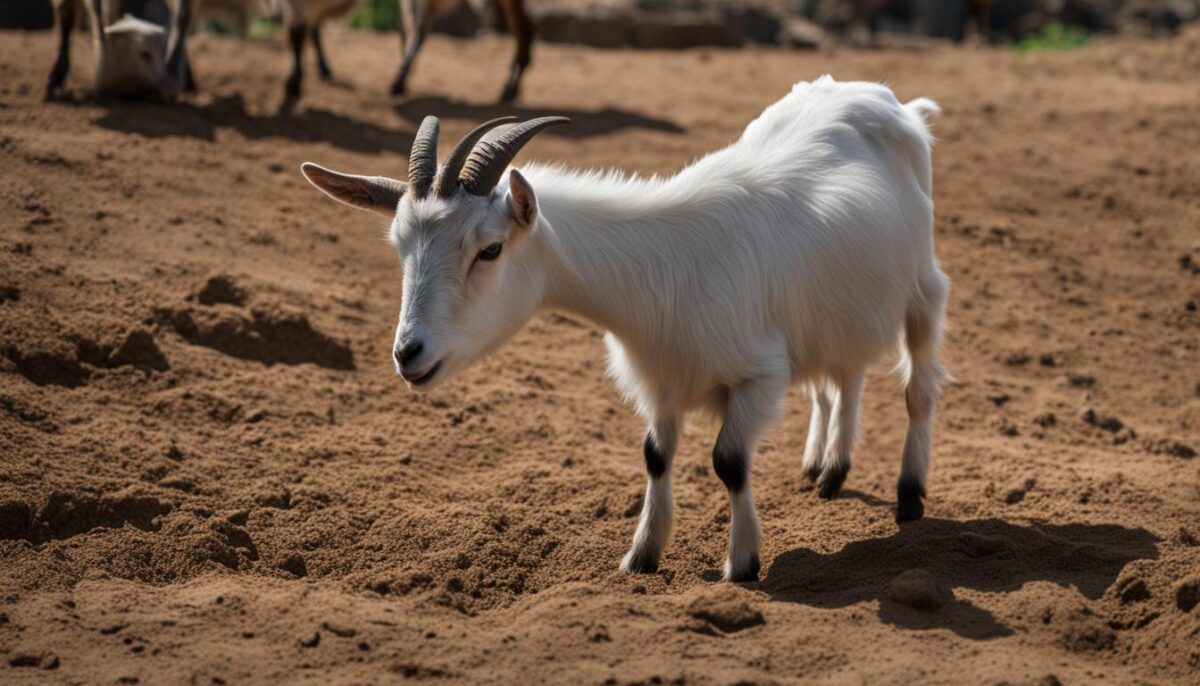
The Curiosity of Goats: Climbing and Playing
Goats are known for their playful and curious nature, and their behavior reflects their innate desire for exploration and stimulation. One of the most fascinating behaviors observed in goats is their love for climbing. These agile creatures have a natural instinct to climb on various objects, from rocks and stumps to platforms and even trees. This behavior is not only an expression of their curiosity but also serves as a means of exercise and mental stimulation.
When goats engage in climbing, they showcase their incredible agility and balance. They can effortlessly navigate uneven surfaces and reach impressive heights. This behavior is particularly prominent among young goats, known as kids, as they use climbing as a way to practice their physical abilities and build strength. Climbing also allows goats to access elevated areas where they can find better food sources or take a safe vantage point to survey their surroundings for potential threats.
Goat Playfulness and Exploration
Another aspect of goat behavior closely related to climbing is their playfulness. Goats are inherently playful animals and enjoy engaging in various playful activities. They exhibit behaviors such as bouncing, jumping, and butting heads with each other, displaying their energy and enthusiasm. This playful behavior is not only entertaining to watch but also essential for their overall well-being.
To cater to their natural playfulness, it is important to provide goats with enriching environments that stimulate their curiosity. This can be achieved by providing them with climbing structures, such as spools, stumps, and shelves, which allow them to engage in their natural behavior and explore their surroundings. Additionally, offering toys and objects to interact with can keep goats entertained and prevent boredom. By encouraging their playful nature, we can ensure that goats lead healthy and happy lives.
| Benefits of Goat Climbing and Playfulness | |
|---|---|
| 1. Physical Exercise | Goats climbing and playing helps them develop and strengthen their muscles, promoting overall physical fitness. |
| 2. Mental Stimulation | Engaging in playful activities and exploring their environment provides goats with mental stimulation and helps prevent boredom and behavioral issues. |
| 3. Bonding and Social Interaction | Playing and climbing together allows goats to bond with each other and establish social hierarchies within the herd. |
| 4. Natural Instincts | Goats’ climbing behavior reflects their natural instincts and allows them to explore their surroundings and find better food sources. |
Overall, understanding the climbing and playful behavior of goats is essential for goat owners and enthusiasts. By providing them with opportunities to climb and play, we can ensure that they lead enriched and fulfilling lives while promoting their physical and mental well-being.
Head Butting: Establishing Dominance in Goat Herds
Head butting is a common behavior among goats and serves as a means of establishing dominance within a herd. In a goat herd, there is a social hierarchy where each goat has a specific rank or status. This hierarchy is determined through various rituals and interactions, with head butting being one of the primary methods. Goat engage in head butting to display dominance over other goats and to settle disputes. It is a natural behavior that helps establish order within the group and reduces conflict.
Goats engage in head butting by forcefully colliding their heads with another goat’s head or body. This behavior is usually not harmful, especially when it involves goats without horns. However, when horned goats are involved, head butting can potentially cause injury. It is important for goat owners to be cautious when introducing new goats to establish social dynamics without causing harm to the animals. Head butting is a normal part of goat behavior and should be understood within the context of herd dynamics.
Understanding Goat Hierarchy and Head Butting
In a goat herd, the hierarchy is established through a series of interactions and dominance displays. Head butting is one of the ways goats communicate and assert their rank within the group. The more dominant goats typically use head butting to establish their authority and maintain their position in the hierarchy. This behavior also helps to settle conflicts and maintain order within the herd.
It’s important to note that the hierarchy within a goat herd can change over time, especially when new goats are introduced or when goats leave the herd. These changes may result in shifts in the social dynamics and the establishment of new dominance relationships. By understanding the dynamics of goat hierarchy and head butting, goat owners can better manage their herds and promote a harmonious social environment for their animals.
| Advantages of Head Butting in Goat Herds | Disadvantages of Head Butting in Goat Herds |
|---|---|
|
|
Overall, head butting is an important aspect of goat behavior and plays a significant role in establishing dominance within a herd. Understanding goat hierarchy and the purpose behind head butting can help goat owners create a balanced and socially harmonious environment for their animals.
Other Interesting Goat Behaviors
Goats are fascinating creatures that exhibit a range of interesting behaviors. Their intelligence and adaptability are evident in the various ways they interact with their environment and each other. Understanding these behaviors can provide valuable insights into goat behavior and enhance our overall understanding of these remarkable animals.
One interesting behavior that goats display is their ability to solve puzzles and respond to commands. Through research studies, goats have been trained to learn their names and perform simple tasks such as “get up” and “come.” Their excellent memory allows them to remember these tasks even after a long time. Goats are highly motivated by food and respond well to positive reinforcement training methods.
In addition to their cognitive abilities, goats exhibit unique behaviors specific to their reproductive and social interactions. For example, goats raise their upper lip in a behavior known as the Flehmen response to gather information about scents and pheromones in their environment. They also engage in climbing and resting on top of objects, showcasing their agility and providing them with a safe place to observe their surroundings. Furthermore, goats may display fake displays of fitness as a way to establish dominance and social hierarchies within their herds.
Overall, exploring these interesting goat behaviors not only highlights their distinct characteristics but also allows us to appreciate their complex social dynamics and adaptability. By studying and understanding goat behavior, we can create enriching environments that promote their well-being and enhance our interactions with these fascinating animals.
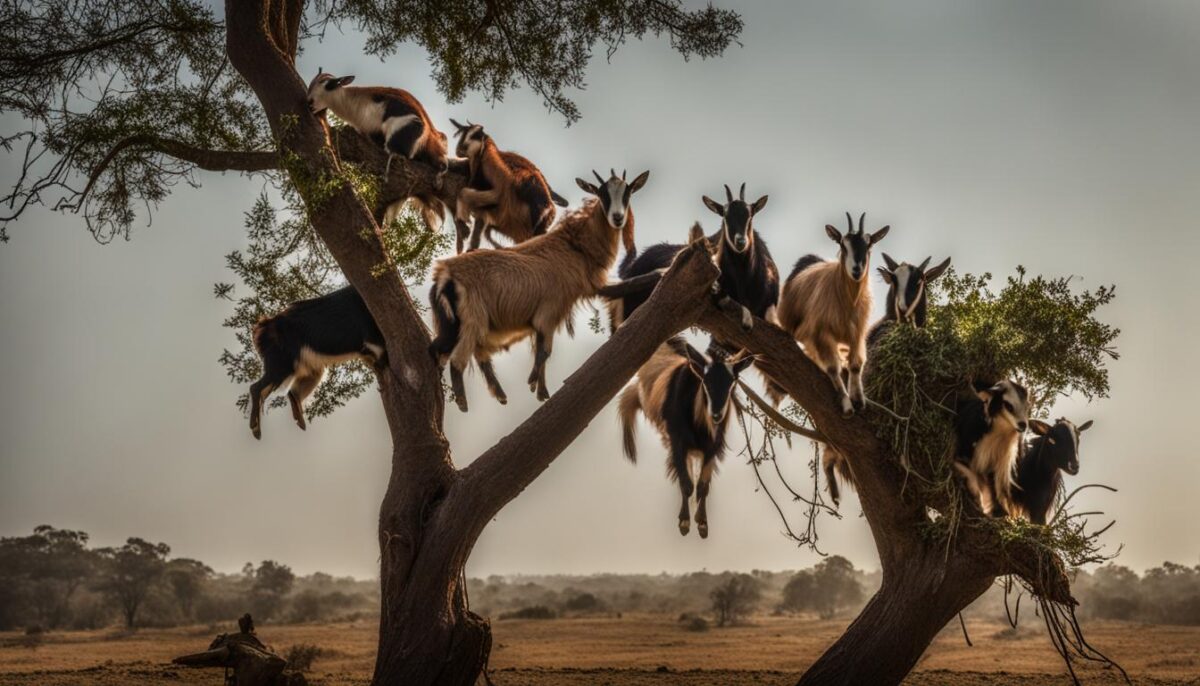
The Flehmen Response: A Fascinating Phenomenon in Animal Behavior
The Flehmen response is a captivating behavior observed in various animals, including goats, horses, giraffes, and cats. This unique behavior involves the curling of the upper lip and the sniffing of the air. The purpose of the Flehmen response is to gather valuable information about interesting or unfamiliar scents, particularly pheromones. This response is triggered when animals detect a scent that piques their curiosity.
The Flehmen response is closely tied to an animal’s olfactory sense. Animals possess an olfactory sensory organ called the Jacobson’s organ, which is situated on the roof of their mouth. This organ allows them to “smell” and detect pheromones, which are chemical signals that play a crucial role in animal communication. By lifting their upper lips and directing scents towards the Jacobson’s organ, animals can gather important information about their environment and other animals.
The Flehmen response is a remarkable example of the intricate and fascinating behaviors exhibited by animals. It highlights their ability to communicate and gather essential information through their sense of smell. By curling their lips and engaging in this behavior, animals are able to unlock a hidden world of scents and pheromones, providing insights into their surroundings and the presence of other animals.
The Flehmen response showcases the sophistication and complexity of animal behavior. It is a powerful tool that animals use to navigate their environment, detect potential mates, and communicate with each other. This behavior demonstrates the remarkable sensory abilities and adaptability of animals in their quest for survival and successful reproduction.
Goats’ Foraging Behavior: Browsing and Grazing
Goats are skilled foragers, adapting to find and access nutritious food in their natural mountainous habitat. Their foraging behavior is primarily characterized as browsing, where they selectively choose the most succulent plants, leaves, and herbs. However, goats are also capable of grazing on grasses when more nutritious options are unavailable. Their feeding habits contribute to their ability to survive in challenging environments.
Goats have developed the skill of browsing by standing on their hind legs to reach tree branches and delicately picking leaves and flowers within thorny bushes. This behavior allows them to access a wide variety of food sources and maximize their nutrient intake. Browsing also helps goats to maintain a balanced diet, as they can consume different types of plants and vegetation.
To showcase the contrast between browsing and grazing, the following table provides an overview of the key differences in goat feeding habits:
| Browsing | Grazing |
|---|---|
| Selectively choosing plants, leaves, and herbs | Feeding on grasses |
| Standing on hind legs to reach tree branches | Feeding at ground level |
| Accessing a wide variety of food sources | Limited to grasses available |
| Maximizing nutrient intake | Lower nutrient availability |
It is important to provide goats with a varied diet that satisfies their browsing instincts. This can include offering a mix of browse plants, such as shrubs and trees, along with high-quality grasses. By understanding and accommodating their natural foraging behavior, goat owners can support the overall health and well-being of their animals.
Goat Behavior and Agility: Climbing and Resting on Top of Objects
Goats are known for their impressive agility and natural inclination to climb and rest on top of objects. This behavior is not only fascinating to observe but also serves important purposes in their survival and social dynamics. With their nimble hooves and strong legs, goats are able to navigate various terrains and ascend to higher ground, allowing them to escape potential predators and gain a better vantage point to monitor their surroundings.
This innate climbing behavior starts from an early age as young goats engage in playful activities, honing their skills and building their muscular strength. They often seek out elevated platforms, such as rocks, fallen trees, or even human-made structures, to rest and ruminate. This behavior not only provides them with a safe and secure spot but also allows them to observe their environment and protect themselves from potential threats.
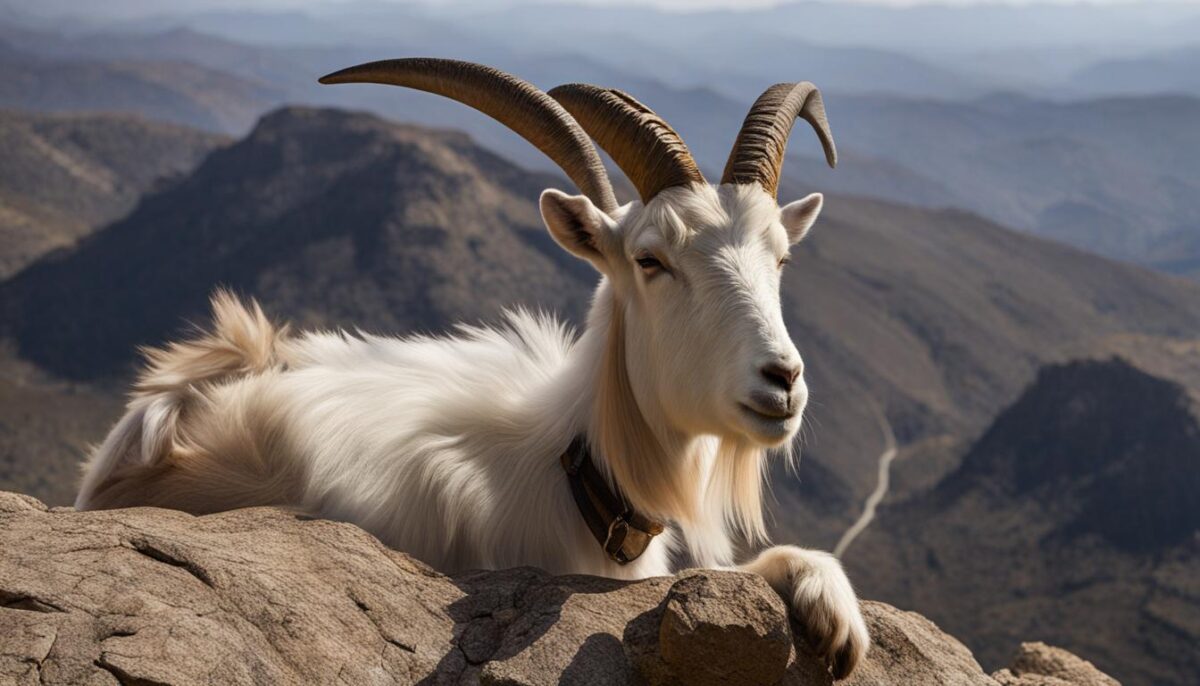
The Benefits of Goat Climbing:
- Enhanced protection against predators
- Improved sightlines for monitoring surroundings
- Opportunity for mental stimulation and exercise
- Resting and rumination in a secure and elevated position
In addition to climbing, goats also exhibit a remarkable ability to balance and rest on top of objects. Whether it’s a narrow tree branch or a sturdy rock, goats can comfortably perch themselves, utilizing their strong core muscles and excellent balance. Resting on top of objects allows goats to conserve energy while still maintaining awareness of their surroundings. It also provides them with an elevated position to reach nutritious leaves and foliage, further supporting their browsing behavior.
Goat Agility and Environmental Enrichment:
It is important for goat owners and caretakers to provide environmental enrichment that promotes their natural climbing and resting behaviors. Creating structures such as platforms, elevated platforms, and sturdy structures for goats to explore and rest on can enhance their physical and mental well-being. Additionally, offering varied and stimulating objects in their environment can prevent boredom and promote their natural behaviors.
Goat Behavior and Social Hierarchies: Establishing Order within the Herd
Goats are social animals that live in herds and establish clear social hierarchies. These hierarchies are essential for maintaining order within the group and reducing conflict. Social hierarchies in goat herds are established through various rituals and interactions, with head butting being a common behavior used to display dominance.
Within a goat herd, each individual has a specific social status or rank. This rank determines its place in the hierarchy and influences its access to resources such as food, water, and shelter. Herd members with higher ranks have preferential access to these resources, while lower-ranking individuals may have to wait their turn or settle for less favorable options.
The establishment of social hierarchies in goat herds is a dynamic process that can change with the addition or removal of individuals. When new goats are introduced to a herd, they must establish their rank through interactions with existing members. This often involves displays of dominance, such as head butting, to assert their position. Over time, the herd members learn to recognize and respect the established hierarchy, resulting in a more stable social structure.
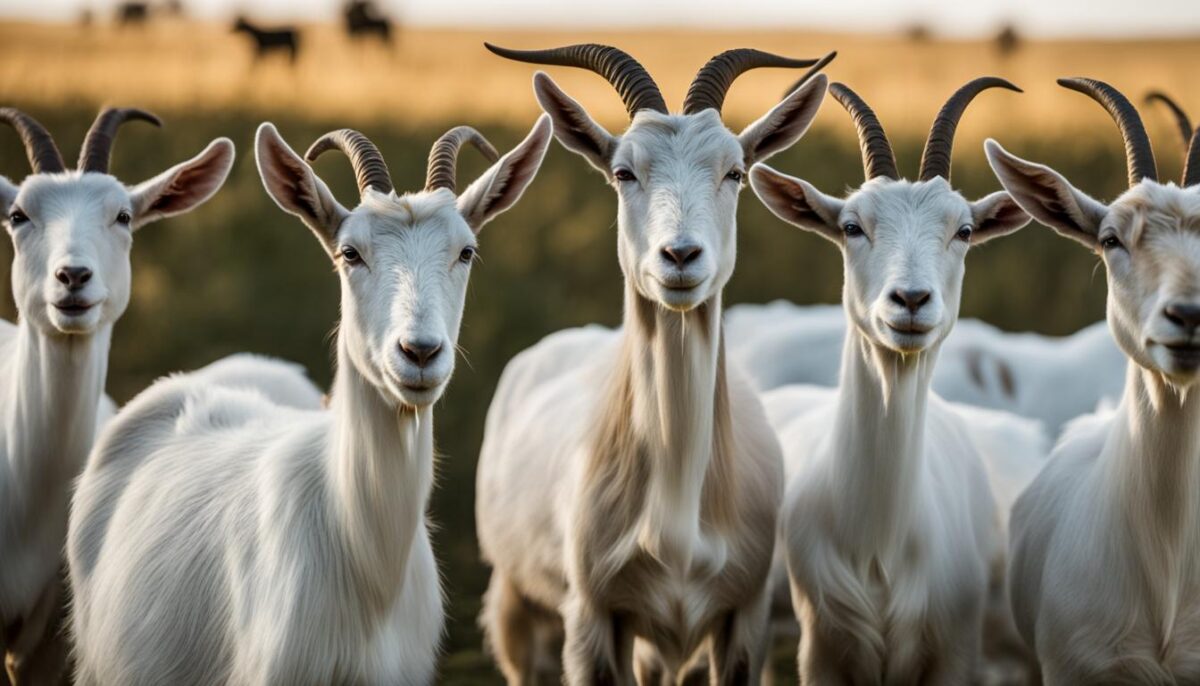
Understanding the dynamics of social hierarchies in goat herds is crucial for proper herd management. It helps goat owners and caretakers identify potential conflicts and ensure that all goats have access to the resources they need to thrive. By providing a balanced and supportive environment, goat owners can promote harmonious interactions within the herd and contribute to the overall well-being of their goats.
Conclusion
The various behaviors exhibited by goats, such as lifting their upper lip, pawing the ground, climbing, and head butting, all serve specific purposes and have meanings within the context of goat behavior. These behaviors reflect the intelligence, adaptability, and social nature of goats. Understanding goat behavior is crucial for goat owners and enthusiasts to provide appropriate care, enrichment, and management strategies. By recognizing and interpreting goat behavior, we can better communicate with these fascinating animals and create a harmonious and enriching environment for their well-being.
Goats possess a complex communication system that involves not only vocalizations but also body language, facial expressions, and scent marking. Through their behaviors, goats convey important information to their herd members, establish dominance, and maintain social hierarchies. Understanding goat communication allows us to better comprehend their needs and emotions, fostering a stronger bond between humans and goats.
The social dynamics within goat herds are intricate and play a vital role in maintaining order and minimizing conflict. Goats establish hierarchical structures through rituals and interactions, with individual goats having specific social statuses. These dynamics can change when new goats are introduced or when goats leave the herd. By understanding the complexities of goat social dynamics, we can create a supportive and harmonious environment for all members of the herd.
Overall, gaining a comprehensive understanding of goat behavior, communication, and social dynamics is essential for responsible goat ownership and management. By applying this knowledge, we can ensure that goats receive the care, enrichment, and social interactions they require for their well-being, happiness, and overall quality of life.
FAQ
Why do goats lift their upper lip?
Goats lift their upper lip in a behavior called the Flehmen response, which allows them to investigate smells and gather information about their environment.
What triggers the Flehmen response in goats?
The Flehmen response is triggered when goats smell something interesting or unfamiliar. It helps them determine the source and nature of the smell.
Do other animals exhibit the Flehmen response?
Yes, the Flehmen response is exhibited by various animals including horses, giraffes, and cats.
Why do goats paw the ground?
Goats may paw the ground to get the attention of their caretakers or other goats. It can also be a hormonal behavior or a way to prepare a comfortable spot to lie down.
Why do goats climb and play?
Goats climb and play as a result of their innate curiosity and their need for mental and physical stimulation. It is a natural behavior that helps satisfy their instincts.
Why do goats engage in head butting?
Head butting is a common behavior among goats and is used as a way to establish dominance within a herd. It is a normal behavior and is used to settle disputes and determine social status.
Can goats be trained?
Yes, goats can be trained using positive reinforcement. They can learn their names, respond to commands, and solve puzzles. They have excellent memories and are highly motivated by food.
What is the purpose of the Flehmen response in animal behavior?
The Flehmen response plays a significant role in animal behavior and communication. It allows animals to gather important information about scents, particularly pheromones, and their environment.
What is the difference between browsing and grazing in goats?
Browsing is the selective eating of the most succulent plants, leaves, and herbs, while grazing refers to eating grasses. Goats are skilled foragers and adapt to find nutritious food in their natural habitat.
Why do goats climb and rest on top of objects?
Goats climb and rest on top of objects as a way to escape predators and observe their surroundings. It is a behavior that reflects their agility and natural instincts.
How do goats establish social hierarchies within their herds?
Goats establish social hierarchies through rituals and interactions, including head butting. Each goat has a specific social status within the herd, and the hierarchy can change when new goats are introduced or leave the herd.


